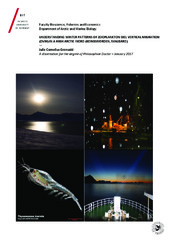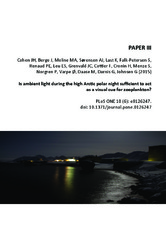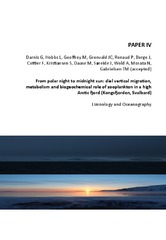| dc.contributor.advisor | Berge, Jørgen | |
| dc.contributor.author | Grenvald, Julie Cornelius | |
| dc.date.accessioned | 2017-04-27T11:35:32Z | |
| dc.date.available | 2017-04-27T11:35:32Z | |
| dc.date.issued | 2017-05-09 | |
| dc.description.abstract | Recent Arctic studies contradict a long-held paradigm of winter quiescence by documenting activity at many trophic levels in the marine food web even during the darkest months of winter. Previous studies have failed to identify which species are performing patterns of vertical migrations during polar night in Kongsfjorden (Svalbard). In the present study, acoustic data supplemented by zooplankton net sampling demonstrated that polar night migration involved several migration patterns. Synchronized diel vertical migration (DVM) was present during the first and final parts of the polar night period, when day-night cycles were more distinct. During the darkest months of mid-winter, synchronized DVM was absent. Mid-winter migration patterns were restricted to surface waters, of unsynchronized character, and did not follow a clear diurnal pattern. Periodically, mid-winter migrations became more synchronized possibly due to enhanced light sources other than solar, such as lunar light. Copepods, chaetognaths and krill (Thysanoessa spp.) were abundant species but krill were responsible for the acoustic migration patterns. Spectral sensitivity tests showed that krill (T. inermis) were able to perceive solar background illumination during mid-winter. A clock gene investigated in krill required light to show circadian rhythmicity. The molecular and electrophysiological experiments suggested that polar night migration was exogenous governed by ambient light levels rather than endogenously controlled, although, light intensity had to be at a certain threshold to show diurnal rhythms. Light levels were probably too low during mid-winter, which explains unsynchronized migration patterns and lack of clock gene rhythms. Predation pressure was not evaluated in the present study but it may be that the ultimate driver for synchronized migration patterns was an anti-predatory response. This study presents a very first glimpse into a biosphere in which the dominant light source appears to trigger a response in zooplankton species, which does not always follow a diurnal pattern. | en_US |
| dc.description.doctoraltype | ph.d. | en_US |
| dc.description.popularabstract | Recent Arctic studies contradict the long-held paradigm of winter quiescence and document activity levels in the marine food web even during the darkest months of winter. A phenomenon that has attained considerable attention is patterns of Diel Vertical Migration (DVM) of zooplankton during the polar night. Why do organisms migrate in a seemingly constant dark environment? This PhD thesis is aimed at examining the general patterns on DVM during the polar night in Svalbard waters, with a main aim of identifying which species are in fact migrating and why they conduct these energetically costly migrations. The results show that polar night DVM is a complex phenomenon, and involves several migration patterns. Zooplankton net sampling, in parallel with acoustics, revealed that krill were dominant species behind migratory patterns. Molecular and electrophysiological experiments showed that ambient light levels rather than endogenous genetic control governed winter migration patterns. | en_US |
| dc.description.sponsorship | The research was funded by the Nordic Research Council funded projects: Circa (NRC project number 214271), Marine Night (NRC project number 226417), and the Arctic Field Grant (project number 235677). | en_US |
| dc.description | The papers I and II of this thesis are not available in Munin. <p>
Paper I: Grenvald, J. C., Callesen, T. A., Daase, M., Hobbs, L., Darnis, G., Renaud, P., Cottier, F., Nielsen, T. G., Berge, J.: “Plankton community composition and vertical migration during polar night in Kongsfjorden”. Available in <a href=http://dx.doi.org/10.1007/s00300-016-2015-x>
Polar Biology 2016, 39(10): 1879–1895. </a>
<p>
Paper II: Grenvald, J. C., Vader, A., Reinardy, H., Berge, J., Renaud, P., Gabrielsen, T. M.: “Does the cryptochrome 2 gene (cry2) act as a circadian clock gene in krill (Thysanoessa spp.) during polar night in Kongsfjorden (Svalbard)? (Manuscript). | en_US |
| dc.identifier.isbn | 978-82-8266-136-2 | |
| dc.identifier.uri | https://hdl.handle.net/10037/10964 | |
| dc.language.iso | eng | en_US |
| dc.publisher | UiT The Arctic University of Norway | en_US |
| dc.publisher | UiT Norges arktiske universitet | en_US |
| dc.rights.accessRights | openAccess | en_US |
| dc.rights.holder | Copyright 2017 The Author(s) | |
| dc.subject.courseID | DOKTOR-002 | |
| dc.subject | VDP::Mathematics and natural science: 400::Zoology and botany: 480::Marine biology: 497 | en_US |
| dc.subject | VDP::Matematikk og Naturvitenskap: 400::Zoologiske og botaniske fag: 480::Marinbiologi: 497 | en_US |
| dc.title | Understanding winter patterns of zooplankton Diel Vertical Migration (DVM) in a high Arctic fjord (Kongsfjorden, Svalbard) | en_US |
| dc.type | Doctoral thesis | en_US |
| dc.type | Doktorgradsavhandling | en_US |


 English
English norsk
norsk

